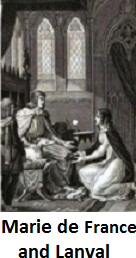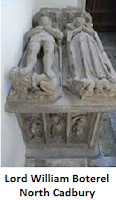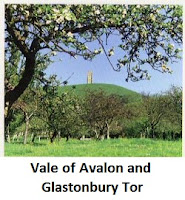
Cadbury Castle, formerly known as Camalet, is a multivallate Iron Age hill fort at South Cadbury in Somerset. You can see the surrounding earthworks in the picture above. Such hill forts were known as 'castelli'. The limestone hill is on the southern edge of the Somerset Levels, of which more anon, close to the villagesof Queen Camel and West Camel on the river Cam. It covers eighteen acres, and overlooks the surrounding countryside as far as Glastonbury.
The name Cadbury comes from Cador's byrg (byrg was Anglo-Saxon for fort/town.)
The first mention of the local tradition that the hill at South Cadbury was King Arthur's Camelot came in 1542 from John Leland, Henry VIII's travelling antiquary. He specifically says that the hill at South Cadbury is called Camelot:-. "Right at the South end of South Cadbury Church stands Camelot. This was once a noted town or castle, set on a real peak of a hill, and with marvellously strong natural defences..... Roman coins of gold, silver and copper have been turned up in large quantities during ploughing there, and also in the fields at the foot of the hill, especially on the East side. Many other antiquities have also been found, including at Camelot, within memory, a silver horseshoe. The only information local people can offer is that they have heard that Arthur frequently came to Camelot."
All this may or may not be so. The King Arthur of legend is a composite figure, but based on fact. Geoffrey's of Monmouth's account shows Arthur as having widely-spread interests – he occurs under that name in mediaeval literature from Brittany, Wales, and other essentially Celtic areas, as Ashe points out. The forest of Broceliande, integral to the legends, is in fact in Brittany. You can visit it yourself.
 The legends themselves are also composites, drawn from various sources and different periods. Morgan le Fay was originally the Welsh goddess, Modron/Morrigan, who lived at Avalon. But Avalon is at Glastonbury, or is it? There is an Avallon in Burgundy, which will be discussed later. At any rate, Arthur's lands were widespread.
The legends themselves are also composites, drawn from various sources and different periods. Morgan le Fay was originally the Welsh goddess, Modron/Morrigan, who lived at Avalon. But Avalon is at Glastonbury, or is it? There is an Avallon in Burgundy, which will be discussed later. At any rate, Arthur's lands were widespread.
In and around Broceliande in Brittany is the famous lake, Viviane's stone circle, Merlin's tomb, and entrances to the other world. But, while Uther and his conquest of Igraine may be typically of the Dark Ages, the later romances are pure 12th century amour courtois!
For example, the story of the adulterous love of Tristan and Iseult, the wife of King Mark of Cornwall, Tristan’s uncle/father, has the same theme as Uther and Igraine. Marie de France wrote a lay about Tristan, called 'Chèvrefeuille'. In English, this equates to 'Goatleaf', a
herb which is an aphrodisiac! She seems to have liked young men because she
went on to write another lay about 'Lanvallay', a knight of the Boterel
family with whom she had an affair, in the late 12th century. 

This lay treats of a knight called 'Lanvallay' leaving Brittany and falling in love with a lady at court in England. The queen is jealous and persuades Arthur to banish Lanvallay, despite Gawain's support. Ultimately, Lanvallay and the maiden gallop off to Avalon, which would account for the fact that the real Lanvallay had no children – at least not in this world.
Geoffrey Ashe believed that “there must have been a tradition about the hill and its powerful overlord, handed down from the Dark Ages". For him, King Arthur was a king/chieftain of the Dumnonii called Riothamus – more below. This tribe had mastered Dorset, Devon, Somerset and Cornwall, where Arthur was born at Tintagel. And it had major influence on the Continent through trade and kindred.
Cadbury Castle was not a castle as such – more a fortified hilltop town large enough to hold a sizeable army amassed by a powerful chieftain. The man who held Camelot was such a chieftain. Ashe wrote an article in the magazine 'Speculum' in April 1981, and went on to back this up in several books. And there is evidence to support his theory in Geoffrey of Monmouth’s Historia Regum, fanciful though this is.

The first excavations were undertaken in 1890 by a local clergyman, the Reverend James Bennett, followed others including by Harold Gray in 1913. In 1966-7 the Camelot Research Committee, led by Leslie Alcock, an archaeologist, carried out more extensive work. You can see many of the finds in the Somerset Museum at Taunton.
Ashe, Secretary of the Camelot Research Committee, refers to Alcock's 1966–70 dig showing that Cadbury Castle, which
had been identified by Leland as Camelot, had undergone massive re-fortification prior to 500AD. So what? Well, Leland had looked at all the probable sites of Camelot, and chose this one even without visible ruins. 400 years later excavations here did indeed throw up late 5th century fortifications and a Great Hall, which must have needed a large amount of manpower – indeed an army – to construct.
The site had been occupied from early Bronze Age times, though several times rebuilt. Certainly it was in use from c. 470 until some time after 580. Alcock's excavations revealed a Great Hall (10x20m), several possible shrines and complex re-fortifications around an imposing town. During the excavations a substantial amount of Tintagel pottery from Cornwall was found, as well as artefacts from Mediterranean lands. Cadbury Castle was thus a major trading centre with Europe. And legend has it that King Arthur was born at Tintagel.
The late 5th century re-fortifications of Cadbury may have been a response to
 the battle of c.470AD. If Arthur was indeed conceived at Tintagel, as tradition asserts, he may have been a chieftain of Dumnonia with Cadbury as his stronghold. The location makes good military sense as a stronghold of the Brythonic Celts of Dumnonia against attacks from the east and north – from the Picts, introduced by Vortigern, and then the Saxons.. The Dumnonii covered at least Cornwall, Devon, Dorset, and Somerset.
the battle of c.470AD. If Arthur was indeed conceived at Tintagel, as tradition asserts, he may have been a chieftain of Dumnonia with Cadbury as his stronghold. The location makes good military sense as a stronghold of the Brythonic Celts of Dumnonia against attacks from the east and north – from the Picts, introduced by Vortigern, and then the Saxons.. The Dumnonii covered at least Cornwall, Devon, Dorset, and Somerset.
The 10th century Annales Cambriae record that these fortifications were destroyed after Arthur's final battle, the Battle of Camlann in 537AD, by Mark, King of Cornwall (come to recover his wife from Tristan, his nephew or possibly his son). But the Annales are decidedly unreliable about dates, being written 400 years after Arthur/Riothamus. Based on a letter from Sidonius Apollinaris, the battle may have occurred around 470AD with the fortifications destroyed soon after.
The 9th century “Life of Paul Aurelian”, records that Cunomorus ruled Cornwall in the early sixth century. Mark is another name for this king whose stronghold was at Castle Dore, Fowey. In a Welsh tale, Mark has the ears of a horse ('march' is Welsh for horse– hence the nickname - cf Midas).
The 6th' century Tristan Stone' near Fowey is inscribed:-
DRVSTANVS HIC IACIT CVNOWORI FILIV'S
So Drustan/Tristan was the son of Cunomorus/Mark. Leland recorded the stone as having another vanished line:-
CVM DOMINA OUSILLA.
And 'Ousilla' is the Latin version of Iseult.
The importance of the Arthurian myths in the Middle Ages should not be underestimated. Richard, Earl of Cornwall rebuilt Tintagel Castle, Arthur's birthplace in the lands of the Dumnonii. Arthur's Great Hall at Camelot was traditionally the site of the original Round Table showing King Arthur and his knights. Nonsense perhaps, but for centuries such a table has been displayed in the Great Hall of Winchester Castle. It's not Arthur's, but why would one have ever been made were there not a tradition based on fact?
Henry III had one made and displayed specially. Richard of Cornwall's nephew, Edward I, replaced Henry's table with the extant version after a fire. (he further ravaged Wales to seize the ‘Crown of Arthur’ from the Welsh princes.) Henry VIII later had the centre of that one overpainted to show the Tudor rose.
Cadbury Castle in Dorset is very close to the villages of Queen Camel and West Camel on the river Cam. Strong local traditions link Arthur’s Camelot and Cadbury Castle. The well on the way up the hill is known locally as Arthur’s Well. Montacute House nearby has a 17th century statue of Arthur, and over the A330 is King Arthur's school. Local traditions are strong.
Eleven miles away is Glastonbury Tor,-a place of mystery and location of Avalon – with a connection called 'King Arthur’s Hunting Track' linking the two sites. The Tor was virtually an island, completely surrounded by marshlands. When the Somerset Levels flooded, as they still do, you could have rowed between the two.

So there are strong indications that Cadbury Castle is Camelot, and that Arthur ended up at Avalon/Glastonbury. In the late 12th century, the monks at the abbey claimed to have discovered a massive coffin carved from a treetrunk. and a leaden cross 16' down, bearing the inscription:-
'Hic jacet sepultus inclitus rex Arturius in insula Avalonia.'
("Here lies buried the renowned King Arthur on the island of Avalon").What could the monks have been doing digging that deep? Does the cross look genuine 5th century? At any rate, the abbey prospered from pilgrims – what a surprise! Edward I made political capital from it a hundred years later when he reburied the remains with great ceremony before the High Altar.
But there is a wider story.....
 Riothamus was a real king of the mid 5th century. The 6th-century British historian, Jordanes, refers to him as 'King of the Britons'. This does not mean that he was a king in what is now England. It means that he was a chieftain of the Brythonic Celts (the British/Bretons) who had spread all over SW England and the near Continent. Modern Brittany was known as 'Armorica'.
Riothamus was a real king of the mid 5th century. The 6th-century British historian, Jordanes, refers to him as 'King of the Britons'. This does not mean that he was a king in what is now England. It means that he was a chieftain of the Brythonic Celts (the British/Bretons) who had spread all over SW England and the near Continent. Modern Brittany was known as 'Armorica'.Riothamus was the son of King Deroc II of Dumnonée – a region on the north coast of Brittany, now known as Penthièvre - who had to flee to Britain as a child. An interesting synchronicity - both Penthièvre and the manor of North Cadbury used to belong to the Boterel family. And, oddly enough, I have ended up living 8 miles from there.
The name, 'Rigotamus '' was in fact more of a title than a name. Nennius tells us that Ambrosius Aurelianus was supreme chief of all the Brythons in England and the Franks on the Continent. 'Supreme Chief' translates as 'Riothamus'. Fleuriot, a French historian, suggests in 'Les origines de la Bretagne' that after the battle in what is now France against the invading Goths, Ambrosius returned to Britain to continue the war against the Saxons (Marie de France records incursions as Picts and Scots.) Arthur may then have been Ambrosius, although the dates are a problem. If Arthur died at Camlann in 537AD, would he have been militarily active in the middle of the previous century?

Jordanes says that Riothamus led a British army of 12,000 men to support the Romans against the Goths in Burgundy in the mid 5th century. His 'Origin and Deeds of the Goths' further records that the Romans never arrived. Riothamus' army was wiped out at Bourges near Lyons, and he himself was wounded.
Gathering his few remaining forces, he fled to a tribe called Burgundians for shelter. 'Ad quos rex Vesegotharum Eurichus innumerum ductans advenit exercitum diuque pugnans Riutimum Brittonum rege, antequam Romani in eius societate coniungerentur, effugavit. Qui amplam partem exercitus amissam cum quibus potuit fugiens ad Burgundzonum gentem vicinam Romanisque in eo tempore foederatam advenit.'
Gregory of Tours in his Historia Francorum (II.18) further adds :'Brittani de Bituricas a Gothis expulsi sunt, multis apud Dolensim vicum peremptis'. The Bretons were thrown out of Bourges by the Goths, and many were annihilated at Bourg de Deols.
Ashe, in his 'The Discovery of King Arthur' (Guild Publishing, London, 1987) notes that Riothamus' last known position in the war was near the town of Avallon in the forest of Morvan. He also notes that here is some suggestion that Riothamus was betrayed by the imperial prefect of Gaul, who held back the Roman forces. This mirrors the betrayal of Arthur by Mordred, the later betrayal of Roland by Ganelon, and the betrayal of Constans by Vortigern – stories that ran the rounds of mediaeval Europe.

Early in 5th century Vortigern (c 400-460AD), had invited the Picts to move south, the Roman walls being no longer a manned barrier. With their support, the usurper betrayed and murdered King Constans, the father of Ambrosius and Uther. The brothers were smuggled to Brittany, where they established themselves among the Brythonic tribes.
Forced eventually to confront the Gothic invasions, Ambrosius/Riothamus agreed to meet up with the Romanic forces at Bourges. (Fleuriot's opinion is that Ambrosius was the supreme leader Riothamus. who led a Brythonic force against the Goths in Burgundy c.470AD.) But the Romans never arrived, and the Brythons were under-supported. It was a disaster. Ambrosius gathered his remaining men and sought safety south in a small town called Avallon. (It's actually northeast of Bourges).
Recovered from their wounds, the brothers made their way to Brittany. But the situation was dire in Britain. Vortigern's treachery earlier in the century, had shown the Picts, Scots and Saxons how weak Britain was. The fiftyish Ambrosius gathered a force, crossed the Channel to Cadbury Castle and led the army there against the Saxon invaders. They were encamped at Badbury Rings, some twenty five miles southeast of Cadbury.
The Battle of Mount Badon in 470AD, saw the harassed Ambrosius squash the Saxons a few months later - (Bede places the date later in 5th century). He spent the next ten years strengthening the fortifications of his oppidum, At his death in 480AD, his nephew, Arthur (son of Uther), became chief. He died at the Battle of Camlann, and the leaderless British/Brythons failed to maintain the fortifications.
It's difficult to decide whether Riothamus was Ambrosius or Arthur or perhaps the title of both. But further indication that Arthur and Riothamus were at least related comes from Tennyson. Where did he get his information? He may have heard of the continental battle with Lyon, Bourges and Avallon near Burgundy, and connected it with Camlann. Many scholars have struggled to locate a mythical Lyonesse, but perhaps it wasn't entirely mythical- just confused:-
“So all day long the noise of battle roll'd
Among the mountains by the winter sea;
Until King Arthur's table, man by man,
Had fallen in Lyonnesse about their Lord,
King Arthur:”
And the poem ends with the death/translation of Arthur through the veil:-
“Then saw they how there hove a dusky barge
Dark as a funeral scarf from stem to stern,
Beneath them; and descending they were ware
That all the decks were dense with stately forms
Black-stoled, black-hooded, like a dream—by these
Three Queens with crowns of gold—and from them rose
A cry that shiver'd to the tingling stars,
And, as it were one voice, an agony
Of lamentation, like a wind, that shrills
All night in a waste land, where no one comes,
Or hath come, since the making of the world.”.......
“Then murmur'd Arthur, "Place me in the barge,"
And to the barge they came. There those three Queens
Put forth their hands, and took the King, and wept.”......
“But now farewell. I am going a long way
With these thou seëst—if indeed I go—
(For all my mind is clouded with a doubt)
To the island-valley of Avilion;
Where falls not hail, or rain, or any snow,
Nor ever wind blows loudly; but it lies
Deep-meadow'd, happy, fair with orchard-lawns
And bowery hollows crown'd with summer sea,
Where I will heal me of my grievous wound."
Tennyson: Morte d'Arthur















